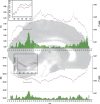White-matter microstructure and gray-matter volumes in adolescents with subthreshold bipolar symptoms
- PMID: 23628983
- PMCID: PMC3965837
- DOI: 10.1038/mp.2013.44
White-matter microstructure and gray-matter volumes in adolescents with subthreshold bipolar symptoms
Abstract
Abnormalities in white-matter (WM) microstructure, as lower fractional anisotropy (FA), have been reported in adolescent-onset bipolar disorder and in youth at familial risk for bipolarity. We sought to determine whether healthy adolescents with subthreshold bipolar symptoms (SBP) would have early WM microstructural alterations and whether those alterations would be associated with differences in gray-matter (GM) volumes. Forty-two adolescents with three core manic symptoms and no psychiatric diagnosis, and 126 adolescents matched by age and sex, with no psychiatric diagnosis or symptoms, were identified after screening the IMAGEN database of 2223 young adolescents recruited from the general population. After image quality control, voxel-wise statistics were performed on the diffusion parameters using tract-based spatial statistics in 25 SBP adolescents and 77 controls, and on GM and WM images using voxel-based morphometry in 30 SBP adolescents and 106 controls. As compared with healthy controls, adolescents with SBP displayed lower FA values in a number of WM tracts, particularly in the corpus callosum, cingulum, bilateral superior and inferior longitudinal fasciculi, uncinate fasciculi and corticospinal tracts. Radial diffusivity was mainly higher in posterior parts of bilateral superior and inferior longitudinal fasciculi, inferior fronto-occipital fasciculi and right cingulum. As compared with controls, SBP adolescents had lower GM volume in the left anterior cingulate region. This is the first study to investigate WM microstructure and GM morphometric variations in adolescents with SBP. The widespread FA alterations in association and projection tracts, associated with GM changes in regions involved in mood disorders, suggest altered structural connectivity in those adolescents.
Figures


References
-
- Tijssen MJ, van Os J, Wittchen HU, Lieb R, Beesdo K, Mengelers R, et al. Evidence that bipolar disorder is the poor outcome fraction of a common developmental phenotype: an 8-year cohort study in young people. Psychol Med. 2010;40:289–299. - PubMed
-
- Lewinsohn PM, Klein DN, Seeley JR. Bipolar disorder during adolescence and young adulthood in a community sample. Bipolar Disord. 2000;2:281–293. - PubMed
-
- Lewinsohn PM, Klein DN, Seeley JR. Bipolar disorders in a community sample of older adolescents: prevalence, phenomenology, comorbidity, and course. J Am Acad Child Adolesc Psychiatry. 1995;34:454–463. - PubMed
Publication types
MeSH terms
Grants and funding
LinkOut - more resources
Full Text Sources
Other Literature Sources
Medical
Research Materials

